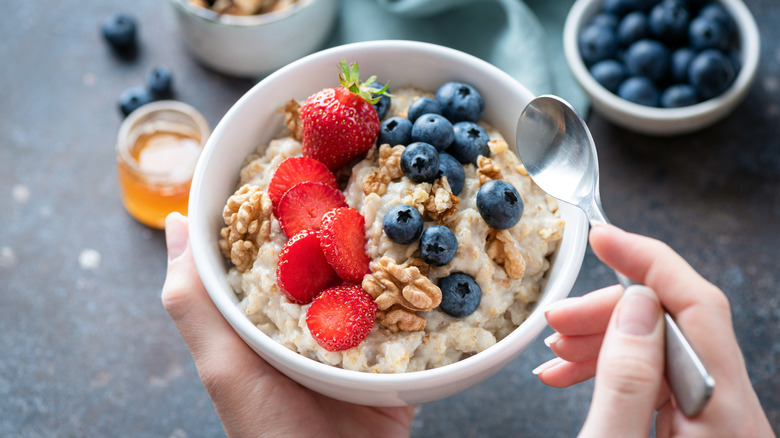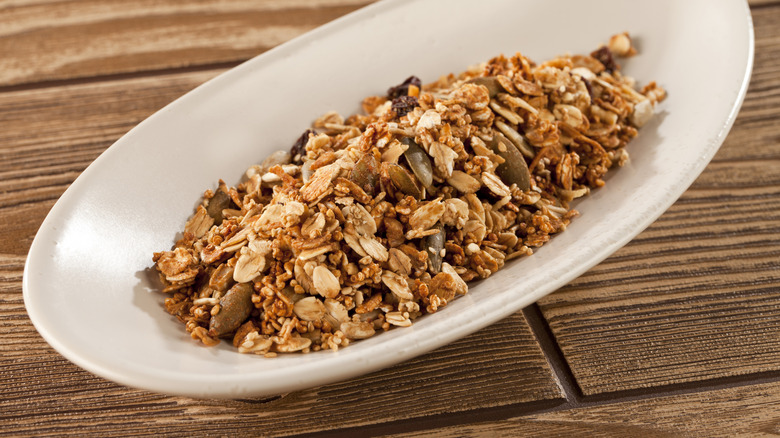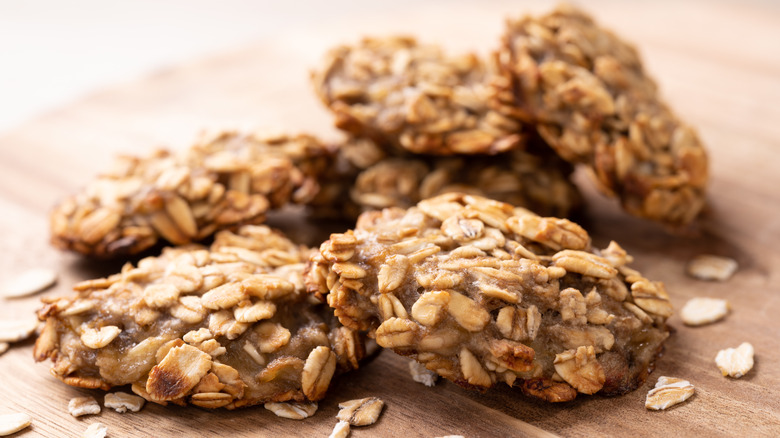Toast Your Homemade Oatmeal To Deepen The Flavor
As good and healthy as oatmeal already is, imagine an added flavor component that transforms what you already considered perfect. And it comes with no added ingredients or special cooking tools –– just a standard kitchen pan and a tiny bit of butter. To take your oatmeal to the next level, we recommend toasting your oats, which is as simple as it sounds.
Toasting oats does a couple of things, both of which are breakfast game-changers. It adds nutty flavor and a toasty aroma, triggering a high sensory appeal, and creates a crispy or slightly chewy texture, bypassing the "mushy" mouth feel that's unappealing to some people. Once cooked, the oats become soft again but with some added depth.
You obviously can't pop those little hulled oat grouts into a slotted countertop bread toaster, but there are plenty of other ways to get roasty and toasty with any kind of processed oats. A stovetop burner, standard oven, or simple toaster oven will do the trick.
Stovetop oatmeal toasting
Toasting oats doesn't necessarily require extra time because it jumpstarts the cooking process, cutting down the overall time required for cooking oatmeal. We all know that can be considerable when preparing whole or steel-cut oats rather than the old-fashioned rolled or instant versions.
You can toast any type of processed oats, with a possible exception being instant or "quick" oatmeal, which undergoes the most amount of processing. They're rolled and steamed into a flatter oat grout with less texture, so they likely won't benefit from the extra heat exposure. Instant oatmeals are also likely to contain pre-added flavors and sugars, which could mask the earthy flavor appeal of toasted oats.
Within five to 10 minutes, depending on your heat source, you'll transform plain, uncooked oats into toasted golden gems headed for your breakfast bowl. Toasting oats on the stovetop gives immediate access and control, letting you toss as needed and gauge color and aroma. Some chefs advocate dry toasting, but using butter deepens the flavor.
Melt about a tablespoon of butter and a pinch of salt in a frying pan, add the oats, and lightly toast for a full five minutes on medium-high heat. The light-brown color tones of the oat may change only slightly, so let your nose be the judge of when to stop. When that nutty aroma rises from the pan, it's time to remove the oats from heat to keep them from overcooking or even burning.
Toasting oats in the oven
Sometimes popping a pan into an oven is easier, especially on rushed school or workday mornings. Using a flat, rimmed cookie sheet or baking pan, spread a light coating of butter, add the oats, and cook at about 350 degrees Fahrenheit for eight to 10 minutes. The oats will absorb the butter, so there's little worry over that burnt-butter taste. However you'll still want to stir every three to four minutes and check periodically for doneness.
A glass pan could help you judge the deepening golden color with a quick peep. The same cooking times apply to toasting oatmeal in a traditional countertop toaster oven, but if using one with convection heating, lower the temperature slightly to about 325 degrees.
Remember that oats aren't always bound for a breakfast bowl, so consider toasting the oats when making oatmeal cookies, energy bars, or even toasted oatmeal waffles. And then there's the nutritious, delicious snack favorite — homemade granola. Toast up those oats with sprinkles of cinnamon, vanilla, honey, coconut flakes, maple syrup, nuts, or anything you desire. With toasted oats as the baseline, you'll be doing your body a mega favor: Oats are brimming with protein, antioxidants, vitamins, minerals, and soluble fiber, according to WebMD.
Even better for healthy meals and snacks on the go, you can toast in large batches for later use. Toasted oats inside an airtight container store well in the pantry, but you'll need to dry-toast them without the butter.



